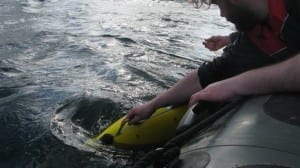
This is robo-fish – scientists’ latest weapon in the war against pollution.
In the shallow waters of Gijon harbour, in northern Spain, a large, yellow fish cuts through the waves.
But this swimmer stands apart from the marine life that usually inhabits this port: there’s no flesh and blood here, just carbon fibre and metal.
This is robo-fish – scientists’ latest weapon in the war against pollution.
This sea-faring machine works autonomously to hunt down contamination in the water, feeding this information back to the shore.
Here in Spain, several are undergoing their first trials to see if they make the grade as future marine police.
“The idea is that we want to have real-time monitoring of pollution, so that if someone is dumping chemicals or something is leaking, we can get to it straight away, find out what is causing the problem and put a stop to it,” explains Luke Speller, a senior scientist at the research division of BMT Group, a technology consultancy.
The company is part of the Shoal consortium, a European Commission-funded group from academia and business that has developed these underwater robots.
“At the moment, in harbours, they take samples about once a month,” says Mr Speller.
“And in that time, a ship could come into the harbour, leak some chemicals somewhere, then it’s gone, all the way up the coastline.
“The idea is that we will use robot fish, which are in the harbour all of the time, and constantly checking for pollution.”
Inspired by nature
The fish, which measure about 1.5m-long, may be a little larger than their real-life counterparts, but their movements closely mimic them.
Ian Dukes from the University of Essex – another partner in the consortium – says that nature was an obvious inspiration for their robot.
He explains: “Over millions of years, fish have evolved the ultimate hydrodynamic shape, and we have tried to mimic that in the robot.
“They swim just like fish; they are really quite agile and can change direction quickly, even in shallow water.”
But the researchers say there are other advantages to a fishy design compared with some other autonomous underwater vehicles (AUVs).
“Traditional robots use propellers or thrusters for propulsion,” says Dr Dukes.
“What we’re trying to do is use the fin of a fish to propel ourselves through the water.
via BBC – Rebecca Morelle
The Latest Streaming News: Robotic fish updated minute-by-minute
Bookmark this page and come back often
Latest NEWS
Latest VIDEO







